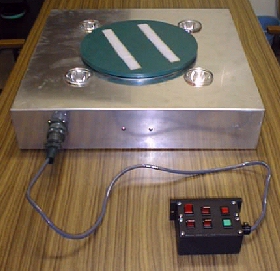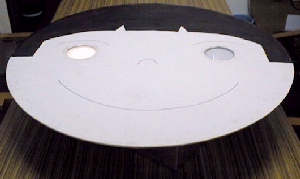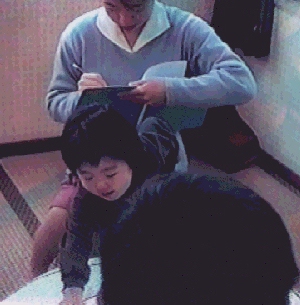The Face Rotation Task
This is an experimental task originally developed
by Watanabe for young children's spatial
perspective taking ability.
Materials. The picture of a girl's face is
used as an experimental stimulus. It is drawn
symmetrically on a disk. The reason for using
such a face is that it has a clear direction
and is familiar to young children. The diameter
of the disk is 80 cm and two holes of 10
cm diameter are made 20 cm apart from the
center of the circle. The holes are covered
with white celluloid boards and represented
eyes. The face stimulus is placed on a square
plinth of 55 × 55 cm and 15 cm in height.
The operation of switches on a control box
enables the presentation of a light in either
right or left eyes and 2 kinds of buzzer
sounds. Additionally the turntable set between
the face and the plinth makes it possible
to rotate the former very smoothly by hand.

the plinth with a control box

an experimental stimulus with a light in right eye
Task. The newly created task was named the
'Face Rotation Task'. In the warm-up session
children are allowed to play with the device.
After they can recognize the stimulus as
a figure of face, the experimental sessions
follow. First, the face is rotated to 90,
180, or 270 degrees. These positions are
called B, C, and D respectively, while the
child's position is A. Either a right or
a left eye is lit and simultaneously one
of two buzzers is sounded. The different
sounds prevent children from feeling the
same sound connecting to the different eyes
confusing. The directions to which the stimulus
is rotated, the position of the lit eye,
and the combinations of the eyes and the
buzzer sounds are randomized. After the experimenter
judges that a child is attending to the light
and the sound, the stimulus is returned to
the original direction. Children are prevented
from perceiving stimulus rotation by having
their attention averted or by closing their
eyes. Immediately after the rotation, only
the buzzer sound that has previously been
used is presented again. This task focuses
on whether children can understand the eye
corresponding to the sound. If anyone can't
answer spontaneously with gazing, pointing,
or utterance, he or she is asked to
suggest which eye should shine.

The interior is an assistant. This side is an experimenter.
The child is pointing at a left eye of the face stimulation.

a response sample (movie)
The logic of the Face Rotation Task is as
follows.
When the sound and light are presented, children
who could take perspectives would move the
imaginary self implicitly to the appropriate
position and imagine looking at the face
from the front. Then they would learn the
correspondence between the presented sound
and light. When the buzzer sounds for a question,
they could answer correctly, because they
would recall the image of the light represented
just before. That is, a correct answer would
mean the implicit perspective taking ability
in them.
Results.
Table 1 Numbers of children who made correct
responses of
B & D or B, C, & D patterns in EXPERIMENT Ⅰ
----------------------------------------------------------
Correct Responses
AGE N B & D B,
C, & D
2:6-2:8 7 2 1
2:9-2:11 3 2 0
3:0-3:2 5 3 0
3:3-3:5 8 2 2
3:6-3:8 8 6 * 4 *
3:9-3:11 8 7 * 4 *
4:0-4:2 13 11 * 6 *
4:3-4:5 6 6 * 4 *
TOTAL 58 39 21
'*' marks means significantly more than expected
values of each correct response pattern (p<0.05).
Numbers of B & D pattern include ones
of B, C & D pattern.
Table 2 Longitudinal (one year) change
of the responses in EXPERIMENT Ⅰ
---------------------------------------------------------------------------------------------
Second
Incorrect Correct TOTAL
B
& D B, C, & D
---------------------------------------------------------------------------------------------
First Incorrect 2 3 5 10
Correct B & D 0 1 0 1
B, C, & D 0 0 1 1
TOTAL 2 4 6 12
The experiments with this task are in the
Japanese Journal of Psychology (71,26-33.
in Japanese).
It's abstract is as follows.
Can three-year old children take spatial perspectives?: An approach with
the ' Face Rotation Task '
M.
WATANABE
Spatial perspective taking ability of 2;6
to 4;5 year old children was investigated
by a newly devised task, named the ' Face
Rotation Task '. One lit eye, right or left,
and a buzzer sound were presented on an illustrated
face which had been rotated to 90, 180, or
270 degrees from children. They were required
to memorize the combination, the face was
rotated back to the child direction of 0
degrees, and the previous sound was presented
again. Children were asked to look or point
at the position of the expected lit eye.
Children of over 3.5 years performed significantly
better than chance expectation. As an attempt
to clarify the mental strategy employed,
thirty-six children who made correct responses
in the first experiment took part in a second
experiment, which consisted of a modified
Face Rotation Task. The result indicated
that the mental strategy used by the children
was perspective taking. The implications
of these results were discussed in terms
of the appropriate meaning of perspective
taking ability.

 Shiga University Otsu Campus
Shiga University Otsu Campus




